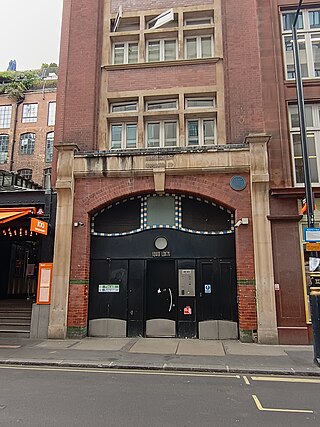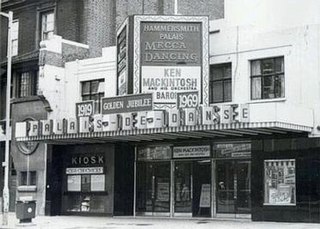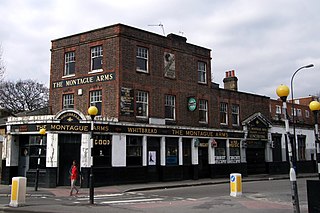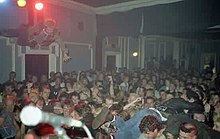
Washington, D.C., has been home to many prominent musicians and is particularly known for the musical genres of Jazz, Rhythm & Blues, bluegrass, punk rock and its locally-developed descendants hardcore and emo, and a local funk genre called go-go. The first major musical figure from District of Columbia was John Philip Sousa, a military brass band composer. Later figures include jazz musicians, such as Duke Ellington, Charlie Rouse, Buck Hill, Ron Holloway, Davey Yarborough, Michael A. Thomas, Butch Warren, and DeAndrey Howard; soul musicians, including Billy Stewart, The Unifics, The Moments, Ray, Goodman & Brown, Van McCoy, The Presidents, The Choice Four, Vernon Burch, guitarist Charles Pitts, and Sir Joe Quarterman & Free Soul.
Australian indie rock is part of the overall flow of Australian rock history but has a distinct history somewhat separate from mainstream rock in Australia, largely from the end of the punk rock era onwards.

The Hammersmith Apollo, currently called the Eventim Apollo for sponsorship reasons, and formerly known as the Hammersmith Odeon, is a live entertainment performance venue, originally built as a cinema called the Gaumont Palace. Located in Hammersmith, London, it is an art deco Grade II* listed building.

Rock City is a music venue and nightclub located in Nottingham, England. It is owned by venue operator and concert promoter DHP Family.

The Diodes are a Canadian punk rock band formed in 1976 in Toronto. They released five albums: Diodes (1977), Released (1979), Action-Reaction (1980), Survivors (1982), and Time/Damage Live 1978 (2010). They were one of the first Canadian bands to embrace this style of music and helped to foster the original core Punk scene in Toronto.
A guerrilla gig is a type of concert performed in a non-traditional setting or arranged in an unusual fashion. It became associated with punk rock, and noise rock bands in UK and the United States during the early to mid-2000s. Bands who perform at such events are sometimes referred to as "guerrilla rockers".

The Marquee Club was a music venue in London, England, which opened in 1958 with a range of jazz and skiffle acts. It was a small and relatively cheap club, in the heart of London's West End.

"11 O'Clock Tick Tock" is a song by Irish rock band U2. It was released as a single on 16 May 1980, and was produced by Martin Hannett. It followed their debut EP Three and the single "Another Day." It was the group's first release for Island Records. The song's lyrics were written by lead vocalist Bono based on his experience at a Cramps concert in London, where he watched a "lifeless, goth-style" crowd from the balcony.
Perth, the major city in Western Australia, has given rise to a number of notable performers in popular music. Some of the more famous performers include Kevin Parker, Troye Sivan, Rolf Harris, David Helfgott, Luke Steele and Tim Minchin. Notable artists in genres including rock, classical, and electronic music have lived in Perth.

The Music in Leeds encompasses a variety of styles and genres, including rock, pop and electronic. While groups like Soft Cell, the Kaiser Chiefs, the Wedding Present, Utah Saints and the Bridewell Taxis have gained success in the mainstream, Gang of Four, the Sisters of Mercy, Chumbawamba and the Mission have helped to define genres like punk rock, gothic rock and post-punk.

The music of Cardiff has been dominated mainly by rock music since the early 1990s with later trends developing towards more extreme styles of the genre such as heavy metal and metalcore music. It, along with the nearby music scene in Newport, has brought a number of musicians to perform or begin their careers in South Wales.

Camden Underworld is a music venue in Camden Town, London, England. The venue is a part of the World's End pub, situated in the basement of the building. It has a capacity of 500 people.

Mayfair Ballroom was a ballroom and concert hall situated on Newgate Street in Newcastle upon Tyne, England. The oblong room was built to hold 1,500 people and had a small stage along one of the longer walls. It was opened in September 1961 by the Mecca organisation.
Klub Foot was a London nightclub in the psychobilly scene of the early and mid-1980s. It started in the heyday of the psychobilly scene in 1982.

The Hammersmith Palais de Danse, in its last years simply named Hammersmith Palais, was a dance hall and entertainment venue in Hammersmith, London, England that operated from 1919 until 2007. It was the first palais de danse to be built in Britain. In 2009, it was named by the Brecon Jazz Festival as one of twelve venues which had made the most important contributions to jazz music in the United Kingdom.

The Crystal Ballroom was a music venue that opened in 1978 in St Kilda, an inner suburb of Melbourne, Australia. Located within the George Hotel at 125 Fitzroy Street, it quickly became the epicentre of Melbourne's post-punk scene, launching the careers of The Birthday Party, Dead Can Dance and other local groups, as well as hosting international acts, including The Cure, New Order and The Fall.

The Half Moon is a Grade II* listed public house at 10 Half Moon Lane, Herne Hill, London. It is one of only 270 pubs on the Campaign for Real Ale's National Inventory of Historic Pub Interiors, was frequented by the poet and writer Dylan Thomas, and was a noteworthy live music venue for nearly 50 years, hosting three gigs by U2 in 1980. In 2015, The Half Moon Public House was listed by Southwark Council as an Asset of Community Value, and is described by Nikolaus Pevsner as, "a cheerful corner pub of 1896".

The Laurie Arms is a pub at 238 Shepherd's Bush Road, Hammersmith, London. It was next door to the Hammersmith Palais, a long running dance hall and music venue from 1919, which hosted The Beatles, The Rolling Stones, The Who, David Bowie and the Sex Pistols, but was demolished in 2013.
The Philadelphia punk scene refers to the vibrant punk rock scene created in Philadelphia, Pennsylvania.

The Montague Arms was a music venue located at 289 Queens Road, in the Telegraph Hill ward of Lewisham, on the borders of Peckham and New Cross in south-east London from 1967 until 2018. The pub venue was known for its eccentric decor; which at some point included old fishing-boat lights, a 19th Century carriage containing a stuffed zebra, and an old diving suit.
















